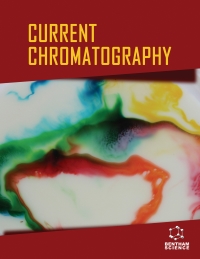- Home
- A-Z Publications
- Current Chromatography
- Previous Issues
- Volume 5, Issue 2, 2018
Current Chromatography - Volume 5, Issue 2, 2018
Volume 5, Issue 2, 2018
-
-
Core-shell Particles: A Way to Greening Liquid Chromatography in Environmental Applications
More LessAuthors: Christophe Waterlot, Alina Ghinet and Emmanuelle LipkaBackground: Since the 1990s, technical developments and theoretical studies of columns packed with core-shell and sub-core-shell particles demonstrated improved efficiency separation, time reduction, solvent use than fully porous columns. Thanks to this chromatographic system, environmental pollutants are being analysed under green conditions. Objective: This paper presents theoretical aspects and a review of Read More
-
-
-
Analytical Methodologies Used in Nanoparticles Remediation Processes for Monitoring of Organic Pollutants. An Overview
More LessAuthors: MariLuz Alonso, Nerea Ayarza, Itxaso S. Román, Luis Bartolomé and Rosa M. AlonsoDifferent nanoparticles have successfully been used in laboratory, pilot and field scale for degradation of organic dangerous pollutants during the last decades. In fact, nanotechnology will, in the near future, play a key role in soil and ground/wastewater decontamination chemical processes. However, since many of the developed techniques for this purpose are still at an experimental or pilot stage, there is a need to demonst Read More
-
-
-
Development and Validation of a Novel HPLC Method for the Analysis and Quantification of Dehydroleucodine in Plant Extracts
More LessAuthors: María L. Mariani and Alicia B. PenissiBackground: Dehydroleucodine is a sesquiterpene lactone isolated from Artemisia douglasiana Besser. Distinctive biological and pharmacological activities have been shown extensively for this molecule. Only one analytical method has been described for the quantification of dehydroleucodine in biological experimental systems. However, this assay involves fluorescent detection that is normally not recommended for routine an Read More
-
-
-
Quantitative Estimation of Alcohol Marker Ethyl Glucuronide (EtG) in Human Hair by LC-MS/MS: An Application Towards Doping Control & Forensic Science
More LessAuthors: Ahi Shobha, Sahu Kapendra, Nasare Mahesh, Singh Satyendra, Beotra Alka and Jain ShilaBackground: Testing of hair samples for drugs of abuse is advantageous as compared to other complementary matrices like urine or blood, due to longer detection window, non-invasive, and easy storage conditions. Ethyl glucuronide (EtG) is a promising biomarker for the identification of alcohol abuse in doping control or forensic analysis. Objective: This paper introduces a fast and sensitive method for determination of Et Read More
-
-
-
Effect of Organic Modifier on Elution Behavior of Voriconazole in Supercritical Fluid Chromatography: Development of Validated SFC Method
More LessAuthors: Pawan K. Porwal, Sanjay D. Sawant and Santosh R. TambeBackground: Voriconazole (VORI), a derivative of fluconazole, shows a greater selectivity for the fungal enzyme than for the corresponding rat liver enzyme as compared to Ketoconazole and Itraconazole. Methods: An environment friendly, simple, rapid, and isocratic robust supercritical fluid chromatographic method has been developed and validated for determining Voriconazole (VORI) in Bulk drug and laboratory mixture re Read More
-
Most Read This Month
Article
content/journals/cchg
Journal
10
5
false
en


